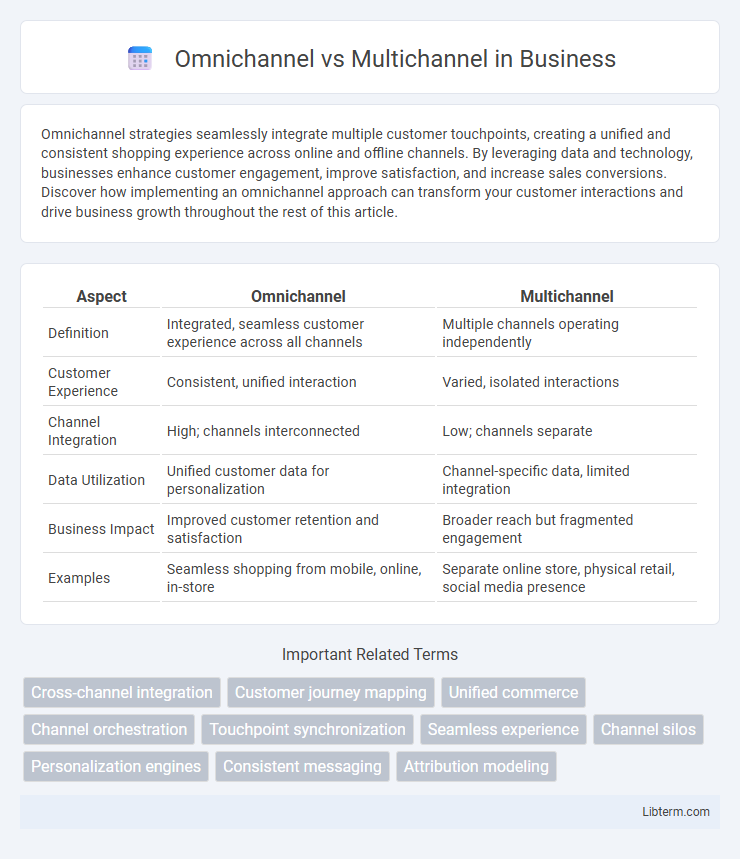Omnichannel strategies seamlessly integrate multiple customer touchpoints, creating a unified and consistent shopping experience across online and offline channels. By leveraging data and technology, businesses enhance customer engagement, improve satisfaction, and increase sales conversions. Discover how implementing an omnichannel approach can transform your customer interactions and drive business growth throughout the rest of this article.
Table of Comparison
| Aspect | Omnichannel | Multichannel |
|---|---|---|
| Definition | Integrated, seamless customer experience across all channels | Multiple channels operating independently |
| Customer Experience | Consistent, unified interaction | Varied, isolated interactions |
| Channel Integration | High; channels interconnected | Low; channels separate |
| Data Utilization | Unified customer data for personalization | Channel-specific data, limited integration |
| Business Impact | Improved customer retention and satisfaction | Broader reach but fragmented engagement |
| Examples | Seamless shopping from mobile, online, in-store | Separate online store, physical retail, social media presence |
Understanding Omnichannel and Multichannel Approaches
Omnichannel and multichannel approaches differ primarily in customer experience integration, with omnichannel providing a seamless, unified journey across all platforms, while multichannel offers multiple independent channels. Omnichannel strategies prioritize consistent messaging and real-time data synchronization to enhance personalization and engagement. Multichannel focuses on maximizing reach by using diverse channels without necessarily coordinating the customer interaction between them.
Key Differences Between Omnichannel and Multichannel
Omnichannel integrates multiple customer touchpoints into a seamless, unified experience, ensuring consistent messaging across online, in-store, and mobile platforms. Multichannel involves using various separate channels to engage customers independently, often resulting in fragmented interactions. The key difference lies in omnichannel's focus on customer journey continuity, while multichannel emphasizes channel quantity rather than integration.
Benefits of Omnichannel Marketing
Omnichannel marketing enhances customer experience by providing seamless interactions across multiple channels, increasing engagement and loyalty. It integrates data and communication, allowing personalized and consistent messaging that drives higher conversion rates. Businesses benefit from improved customer insights and stronger brand presence, resulting in increased revenue and long-term growth.
Advantages of Multichannel Strategies
Multichannel strategies enhance customer reach by leveraging multiple independent platforms such as social media, email, and physical stores, allowing businesses to tap into diverse audience segments effectively. These strategies provide greater flexibility in marketing tactics and allow tailored messaging specific to each channel's unique user behavior. Multichannel approaches also facilitate increased brand visibility and offer multiple touchpoints for customer engagement, improving overall sales opportunities.
Customer Experience: Omnichannel vs Multichannel
Omnichannel customer experience integrates multiple channels to provide a seamless and consistent interaction, allowing customers to switch effortlessly between online, in-store, and mobile touchpoints. Multichannel approaches offer various separate channels without ensuring smooth transitions, often leading to fragmented experiences. Prioritizing omnichannel strategies enhances customer satisfaction and loyalty by delivering personalized and continuous engagement across all platforms.
Data Integration and Personalization
Omnichannel strategies achieve seamless data integration across all customer touchpoints, ensuring a unified view of consumer behavior and preferences. This comprehensive data consolidation enables highly personalized experiences, tailoring content and offers to individual needs in real time. In contrast, multichannel approaches often keep data siloed within separate channels, limiting the depth of personalization and consistent customer interaction.
Challenges in Implementing Omnichannel and Multichannel
Implementing omnichannel strategies faces challenges such as integrating disparate systems to provide a seamless customer experience across all touchpoints, managing real-time data synchronization, and ensuring consistent branding and messaging. Multichannel implementation struggles primarily with siloed operations, inconsistent customer interactions across channels, and difficulty measuring overall campaign effectiveness. Both approaches require robust technology infrastructure and cross-functional coordination to overcome operational complexities and deliver cohesive marketing efforts.
Best Practices for Omnichannel Success
Omnichannel success hinges on seamless integration across all customer touchpoints, ensuring consistent messaging and personalized experiences from in-store to online platforms. Leveraging data analytics to understand customer behavior enables tailored interactions, enhancing engagement and loyalty. Implementing unified inventory management and synchronized communication channels supports real-time responsiveness and boosts operational efficiency.
When to Choose Omnichannel or Multichannel
Choose omnichannel when seamless customer experience across all touchpoints is critical, ensuring consistent messaging and integrated data for personalized engagement. Multichannel suits businesses aiming to expand their presence on various platforms independently, prioritizing broad reach over interconnected interactions. Companies handling complex sales cycles or requiring unified customer journeys benefit most from omnichannel strategies.
Future Trends in Customer Engagement
Future trends in customer engagement emphasize seamless integration across omnichannel platforms, enabling personalized experiences through AI-driven analytics and real-time data synchronization. Multichannel strategies may evolve by enhancing individual channel capabilities, but omnichannel approaches prioritize unified customer journeys across digital, mobile, and physical touchpoints. Innovative technologies like augmented reality and IoT will further transform omnichannel engagement, creating immersive and context-aware interactions that boost customer loyalty and satisfaction.
Omnichannel Infographic

 libterm.com
libterm.com